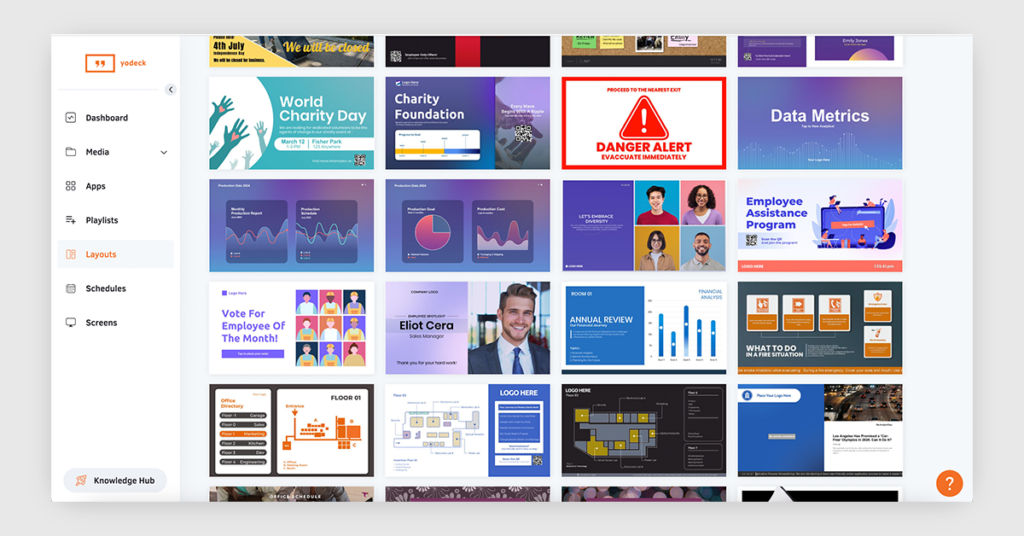Employee engagement is key to boosting employee productivity, innovation, and workplace satisfaction; however, in today’s digital era, where most people work remotely or in hybrid setups, keeping employees engaged has become challenging. Businesses and organizations are now searching for new ways to motivate, connect, and empower their employees to perform at their best.
The old beloved ways, such as in-person meetings, office gatherings, and casual desk conversations, aren’t as common anymore and just don’t work like they used to. Employees are more likely to switch companies when a better opportunity arises, making loyalty to an organization harder to sustain. Moreover, disengagement leads to lower performance, a decline in company culture, and reduced collaboration. To address these challenges, businesses must take advantage of the technology they have on their hands and use it to ensure that employees feel informed, valued, and connected.
Technology for employee engagement
Organizations are embracing various digital tools that enhance communication, recognize achievements, and foster a sense of belonging to keep employees engaged in the digital era. These technologies bridge the gap created by remote and hybrid work environments, ensuring that employees remain connected and motivated. Here’s how they make a difference:
Effective communication and collaboration
Without spontaneous office conversations, interactions can become overly formal and distant, leading to failed clear and open communication, which is the heart of employee engagement. Multiple tools help in situations like these by making it easier for employees to stay connected through real-time collaboration. Platforms like Microsoft Teams provide instant messaging, file sharing, and video conferencing, allowing teams to interact more naturally and faster across different locations.
Project management and productivity
Understanding how individual contributions fit into broader company goals can significantly impact engagement. Project management tools help teams stay aligned, track progress, and ensure accountability. Research by McKinsey found that companies that embrace collaborative technologies see a 20-30% increase in productivity. Platforms such as Asana help employees manage tasks, meet deadlines, and collaborate more effectively, fostering a sense of ownership and purpose.
Feedback and recognition
When employees feel heard and valued, their performance thrives, and companies can easily collect feedback and give recognition thanks to certain solutions. Continuous performance feedback is made possible by platforms such as 15Five, which allow management to address issues and employees to express their opinions proactively. Regarding acknowledgment, platforms like Bonusly promote peer-to-peer gratitude, creating an environment where success is celebrated, eventually boosting morale and engagement.
Learning and development
Career growth is a crucial factor in employee satisfaction, and companies that invest in a learning environment tend to see their employees more motivated to improve and contribute. Online learning platforms such as LinkedIn Learning provide employees with on-demand courses that help them build new skills and stay competitive. Additionally, internal knowledge-sharing systems allow employees to access valuable resources at their own pace, ensuring ongoing professional development.
Employee wellness and work-life balance
With employees facing increased workloads and feeling burned out from time to time, technology can again contribute to supporting mental well-being and work-life balance with tools that promote mindfulness and healthy habits. Apps that offer guided meditation, like Headspace, help employees manage stress, while productivity tools like RescueTime assist in better work scheduling, which leads to overall job satisfaction.

An intelligent platform that has it all
One very effective tool for employee engagement that has it all is digital signage. Communication can fall apart in hybrid environments or businesses with multiple locations where not all employees are physically present in the office simultaneously. Digital signage solves this by delivering real-time, engaging, visually appealing content that ensures every employee stays well-informed and motivated.
How digital signage boosts engagement
Keeps employees informed: Important announcements, company news, and event updates can be displayed on digital screens across offices, ensuring information reaches everyone.
Boosts motivation: Highlighting employee achievements, milestones, and company successes fosters a culture of appreciation and recognition.
Encourages interaction: Social media walls or interactive displays allow employees to share moments, ideas, and feedback, making them feel more connected.
Reinforces company culture: Displaying mission statements, team goals, and corporate values helps employees stay aligned with the organization’s vision and boosts company culture.
Delivers training and tips: Digital signage can display quick training videos, industry insights, or productivity tips, making learning more accessible.
How to use digital signage for employee engagement
Use engaging visuals: People process visuals faster than text, so include attractive graphics, videos, and animations.
Keep content fresh and relevant: Regularly update the content to ensure employees see new and valuable information.
Segment content by audience: Customize messages for different departments or locations to make the content more relevant.
Integrate with other tools: To enhance engagement, sync digital signage with collaboration and recognition tools or internal social networks.

What will the future of employee engagement look like?
This is just the beginning, and as technology evolves daily, companies will undergo even greater transformations in managing their day-to-day work. AI and automation will become essential for personalizing the employee experience, while virtual reality will completely change remote collaboration and training, making interactions more engaging.
However, while technology will enhance engagement strategies, its success will ultimately depend on how well it integrates into workplace culture. Companies that embrace collaboration platforms, feedback systems, learning programs, and wellness apps can foster an environment where employees feel valued and connected. Digital signage will continue to be a key tool for delivering important messages engagingly and effectively. When employees are informed, recognized, and empowered, they are more likely to stay productive, motivated, and committed – helping businesses thrive in an ever-changing work landscape.
